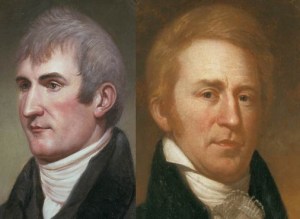Explore the Lewis and Clark route
 Explorers Meriwether Lewis and William Clark were commissioned by President Thomas Jefferson to find a reliable route of waterways from the eastern part of the United States all the way to the Pacific Ocean on the West Coast.
Explorers Meriwether Lewis and William Clark were commissioned by President Thomas Jefferson to find a reliable route of waterways from the eastern part of the United States all the way to the Pacific Ocean on the West Coast.
Lewis, Clark and more than 30 other explorers departed from near St. Louis in May 1804 and reached Fort Clatsop near the Pacific Ocean in November 1805.
In addition to mapping their route, the explorers returned with a significant amount of information about the region through which they had traveled, including geography and plant and animal life.
Today, there are a number of interesting places for visitors to explore along the Lewis and Clark route. Take a look at some of them in this interactive map or in the list below:
Click on icons to view points of interest. (full screen)
- The Lewis and Clark State Historic Site is located in Hartford, Illinois, just south of where the famous duo began their expedition. Over the years, local rivers have changed course, making the original site — Camp Dubois — inaccessible. Features include an interpretive center and a replica of the original Camp Dubois. campdubois.com
- The Lewis and Clark Boat House and Nature Center in St. Charles, Missouri, features full-scale replicas used by the explorers, along with a variety of exhibits detailing the expedition. lewisandclarkcenter.org
- The Fort Osage National Historic Landmark in Sibley, Missouri, is a reconstruction of a fort built under the direction of William Clark that functioned as one of the first United States outposts in the newly acquired Louisiana Territory. fortosagenhs.com
- The Lewis & Clark Missouri River Visitors Center in Nebraska City, Nebraska, features exhibits on animals, plants, boats and other items associated with the expedition. There are six short interpretive trails and 76 total acres used for education about the incredible journey. mrb-lewisandclarkcenter.org
- The Sioux City Lewis & Clark Interpretive Center and The Betty Strong Encounter Center, both located on the same property in Sioux City, Iowa, includes exhibits, interactive devices, artifacts, photos and art related to the expedition. siouxcitylcic.com
- The Lewis and Clark Visitor Center at Gavins Point Dam near Yankton, South Dakota, offers exhibits and displays about the development of the Missouri River Basin region, including information on the early navigation and settlement during the expedition. www.nwo.usace.army.mil/Missions/DamandLakeProjects/MissouriRiverDams/GavinsPoint.aspx
- The Fort Mandan Interpretive Center in Washburn, North Dakota, features state-of-the-art exhibits and a collection of artifacts from the expedition. The original Fort Mandan, likely now under the waters of the Missouri River, was the home to Lewis and Clark during the winter 1804-05. fortmandan.com
- The Lewis and Clark Interpretive Center in Great Falls, Montana, is home to an exhibit hall, a 158-seat theater, an education room for hands-on activities and two hiking trails. www.fs.usda.gov/recarea/lcnf/recarea/?recid=61458
- The Nez Perce National Historical Park consists of 38 sites throughout Idaho, Montana, Oregon and Washington. Lewis and Clark crossed Nez Perce country in the fall of 1805 and the spring of 1806. The Spalding Site in Spalding, Idaho, includes a museum and the park headquarters. www.nps.gov/nepe/
- The Columbia Gorge Discovery Center & Museum in The Dalles, Oregon, includes a section devoted to the cargo carried on the expedition as well as an interactive Lewis and Clark exhibit. gorgediscovery.org
- The Lewis and Clark Interpretive Center on the cliffs of Cape Disappointment State Park in Ilwaco, Washington, includes a mural-sized timeline of panels that guide visitors through the westward portion of the expedition using sketches, paintings, photographs and the words of expedition members themselves. www.parks.wa.gov/187/Lewis-Clark
I want to trek the Lewis & Clark trail. My grandpa and I do living history reenactments of the mid 1700’s to the early 1800’s
That is cool!
Cool